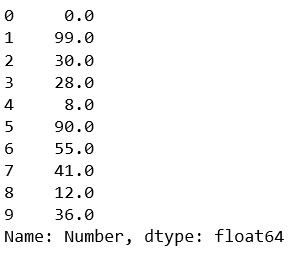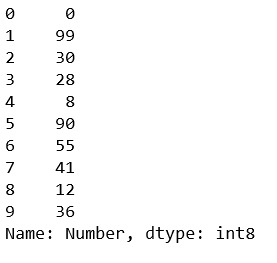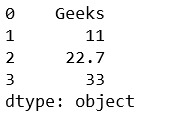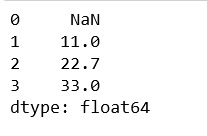Python是进行数据分析的一种出色语言,主要是因为以数据为中心的python软件包具有奇妙的生态系统。 Pandas是其中的一种,使导入和分析数据更加容易。
pandas.to_numeric()是Pandas中的常规函数之一,用于将参数转换为数字类型。
用法: pandas.to_numeric(arg, errors=’raise’, downcast=None)
参数:
arg:列表,元组,一维数组或系列
errors:{'ignore','raise','coerce'},默认为'raise'
->如果为“ raise”,则无效的解析将引发异常
->如果为“强制”,则无效的解析将设置为NaN
->如果为“ ignore”,则无效的解析将返回输入
downcast:[默认无]如果不为None,并且数据已成功转换为数字dtype,则根据以下规则将结果数据转换为可能的最小数字dtype:
->“整数”或“有符号”:最小的有符号整数dtype(最小值:np.int8)
->‘unsigned’:最小的unsigned int dtype(最小值:np.uint8)
->“ float”:最小float dtype(最小值:np.float32)
返回:如果解析成功,则为数字。请注意,返回类型取决于输入。如果为Series,则为Series,否则为ndarray。
代码1:
首先观察该数据集。我们将使用此数据的“数字”列来进行序列化,然后进行操作。
# importing pandas module
import pandas as pd
# making data frame
df = pd.read_csv("https://media.geeksforgeeks.org/wp-content/uploads/nba.csv")
df.head(10)
在Number列上调用Series构造函数,然后选择前10行。
# importing pandas module
import pandas as pd
# making data frame
df = pd.read_csv("nba.csv")
# get first ten 'numbers'
ser = pd.Series(df['Number']).head(10)
ser输出:

使用pd.to_numeric()方法。请注意,通过使用downcast =“ signed”,所有值都将转换为整数。
pd.to_numeric(ser, downcast ='signed')输出:

代码2:使用错误=“忽略”。它将忽略所有非数字值。
# importing pandas module
import pandas as pd
# get first ten 'numbers'
ser = pd.Series(['Geeks', 11, 22.7, 33])
pd.to_numeric(ser, errors ='ignore')输出:

代码3:使用错误=“强制”。它将用NaN替换所有非数字值。
# importing pandas module
import pandas as pd
# get first ten 'numbers'
ser = pd.Series(['Geeks', 11, 22.7, 33])
pd.to_numeric(ser, errors ='coerce')输出:

相关用法
- Python next()用法及代码示例
- Python os.dup()用法及代码示例
- Python set()用法及代码示例
- Python Decimal max()用法及代码示例
- Python PIL ImageOps.fit()用法及代码示例
- Python os.rmdir()用法及代码示例
- Python sympy.det()用法及代码示例
- Python Decimal min()用法及代码示例
- Python os.readlink()用法及代码示例
- Python os.writev()用法及代码示例
- Python os.readv()用法及代码示例
- Python PIL RankFilter()用法及代码示例
- Python os.rename()用法及代码示例
- Python os.sendfile()用法及代码示例
注:本文由纯净天空筛选整理自Shivam_k大神的英文原创作品 Python | pandas.to_numeric method。非经特殊声明,原始代码版权归原作者所有,本译文未经允许或授权,请勿转载或复制。
